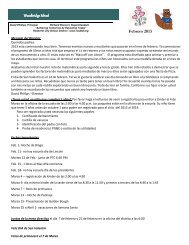A samurai is âone who serves.â In ancient times, the term described ...
A samurai is âone who serves.â In ancient times, the term described ...
A samurai is âone who serves.â In ancient times, the term described ...
Create successful ePaper yourself
Turn your PDF publications into a flip-book with our unique Google optimized e-Paper software.
Chapter 2<br />
Pupil Pages 56–97<br />
You can often find a clue to<br />
<strong>the</strong> meaning of an unfamiliar<br />
new word by breaking it up<br />
into smaller words that you<br />
know. Look at <strong>the</strong> word<br />
oversight (line 19). What<br />
smaller words do you see?<br />
Circle <strong>the</strong> words. Use <strong>the</strong><br />
meanings of <strong>the</strong> smaller<br />
words to help you define<br />
oversight.<br />
Here, oversight means<br />
“superv<strong>is</strong>ion.”<br />
frontier (frun •tir√) n.: developing,<br />
often still uncivilized<br />
or lawless region of a<br />
country.<br />
shogun (◊£√gun≈) n.: any of<br />
<strong>the</strong> military governors of<br />
Japan <strong>who</strong>, until 1868, had<br />
absolute rule.<br />
Underline <strong>the</strong> definitions of<br />
<strong>the</strong>se words, which are given<br />
right in context on th<strong>is</strong> page:<br />
vassals; shogunate; serfs.<br />
Read <strong>the</strong> boxed passage<br />
aloud as if you were reading<br />
to a group of classmates <strong>who</strong><br />
are taking notes as you read.<br />
Make sure you emphasize<br />
<strong>the</strong> words and phrases that<br />
are given special treatment<br />
in <strong>the</strong> paragraph—those in<br />
italics, in paren<strong>the</strong>ses, and<br />
within quote marks.<br />
20<br />
30<br />
40<br />
except for making sure that <strong>the</strong>y received <strong>the</strong> income from<br />
<strong>the</strong>ir agricultural estates. Without effective oversight from<br />
<strong>the</strong> Kyoto court, men in <strong>the</strong> provinces took up arms to<br />
become a professional military class.<br />
<strong>In</strong> that period, <strong>the</strong> Kanto was a frontier area, rich in<br />
farmland and especially in need of men to maintain order<br />
as <strong>the</strong> territory developed. The <strong>samurai</strong> in <strong>the</strong> Kant£ and<br />
elsewhere organized <strong>the</strong>mselves into bands <strong>who</strong>se members<br />
were joined toge<strong>the</strong>r as lords and vassals (followers under<br />
a lord’s protection), much like <strong>the</strong> knights of medieval<br />
Europe.<br />
Although Japan <strong>is</strong> far from Europe and had no contact<br />
with Europeans until <strong>the</strong> mid-sixteenth century, <strong>the</strong><br />
Japanese developed a system of organizing society remarkably<br />
similar to that of medieval Europe. Th<strong>is</strong> system,<br />
known as feudal<strong>is</strong>m, took root in Japan with <strong>the</strong> founding<br />
of its first military government, or shogunate (government<br />
headed by a shogun, or “great general”), in 1185. As in<br />
Europe, feudal<strong>is</strong>m in Japan was based almost entirely on<br />
agriculture. Land divided into estates, or manors, was<br />
worked by peasants called serfs <strong>who</strong> had to remain on <strong>the</strong><br />
land and could not move about freely. Feudal<strong>is</strong>m also<br />
featured a ruling warrior or military class made up of lords<br />
and <strong>the</strong>ir vassals.<br />
<strong>In</strong> <strong>samurai</strong> society, a vassal was supposed to give<br />
absolute, unquestioning loyalty to h<strong>is</strong> lord and even be<br />
prepared to die for him in battle. <strong>In</strong> fact, <strong>the</strong> relationship<br />
between a lord and vassal went both ways: <strong>In</strong> return<br />
for performing military service, a vassal expected rewards<br />
and protection from h<strong>is</strong> lord. The idea of <strong>the</strong> loyal,<br />
self-sacrificing vassal was often ignored. Many vassals,<br />
84 Chapter 2 Characters: The People You’ll Meet<br />
50<br />
Frightening <strong>the</strong> enemy was part of <strong>the</strong> strategy of <strong>the</strong><br />
<strong>samurai</strong>. <strong>In</strong> battle, <strong>the</strong>se warriors wore fierce-looking<br />
masks and fought fiercely, too.<br />
especially in <strong>the</strong> tumultuous fifteenth and sixteenth<br />
centuries, betrayed or rebelled against <strong>the</strong>ir lords.<br />
The <strong>samurai</strong> continued to rule Japan until <strong>the</strong> beginning<br />
of <strong>the</strong> modern period in 1868. During <strong>the</strong> time of <strong>the</strong><br />
last military government, <strong>the</strong> shogunate of <strong>the</strong> Tokugawa<br />
family (1600–1867), Japan remained almost entirely at<br />
peace. Deprived of <strong>the</strong>ir profession of warfare, many<br />
• • • • • • Notes • • • • • •<br />
tumultuous<br />
(tº •mul√¬º •w¥s) adj.:<br />
full of d<strong>is</strong>turbance or<br />
upheaval; unsettled.<br />
The Samurai 85<br />
162 <strong>In</strong>teractive Reading: Teacher’s Edition














